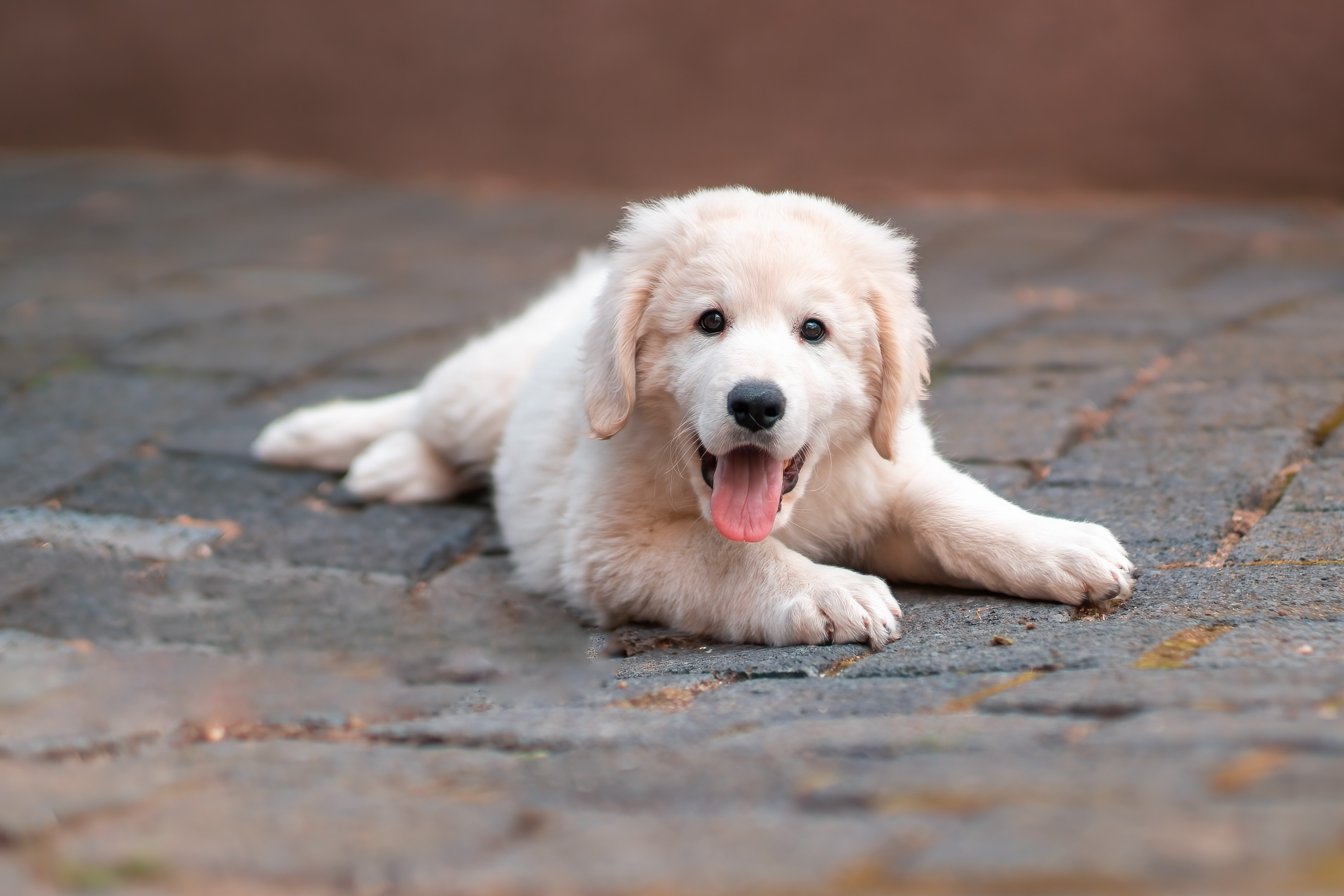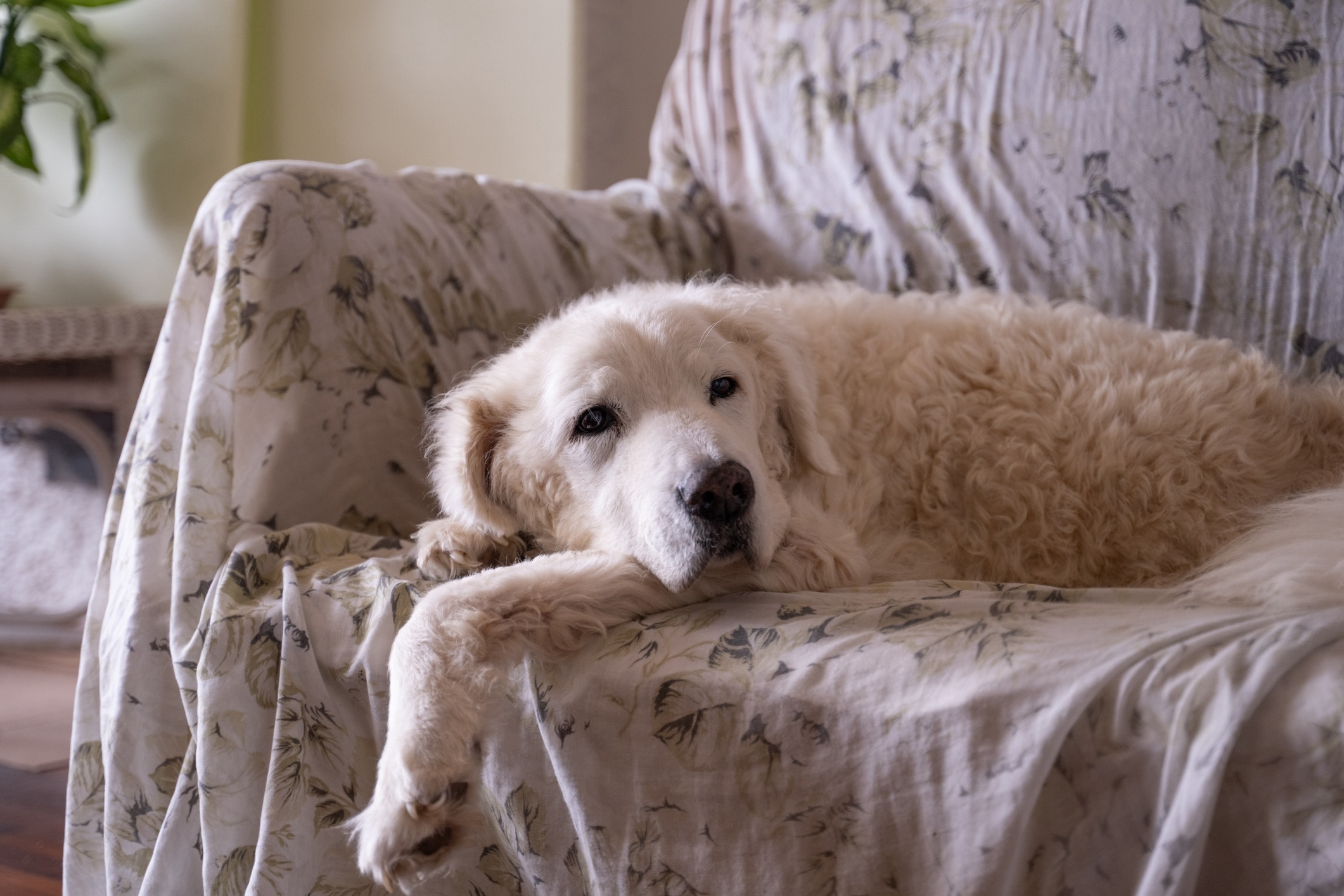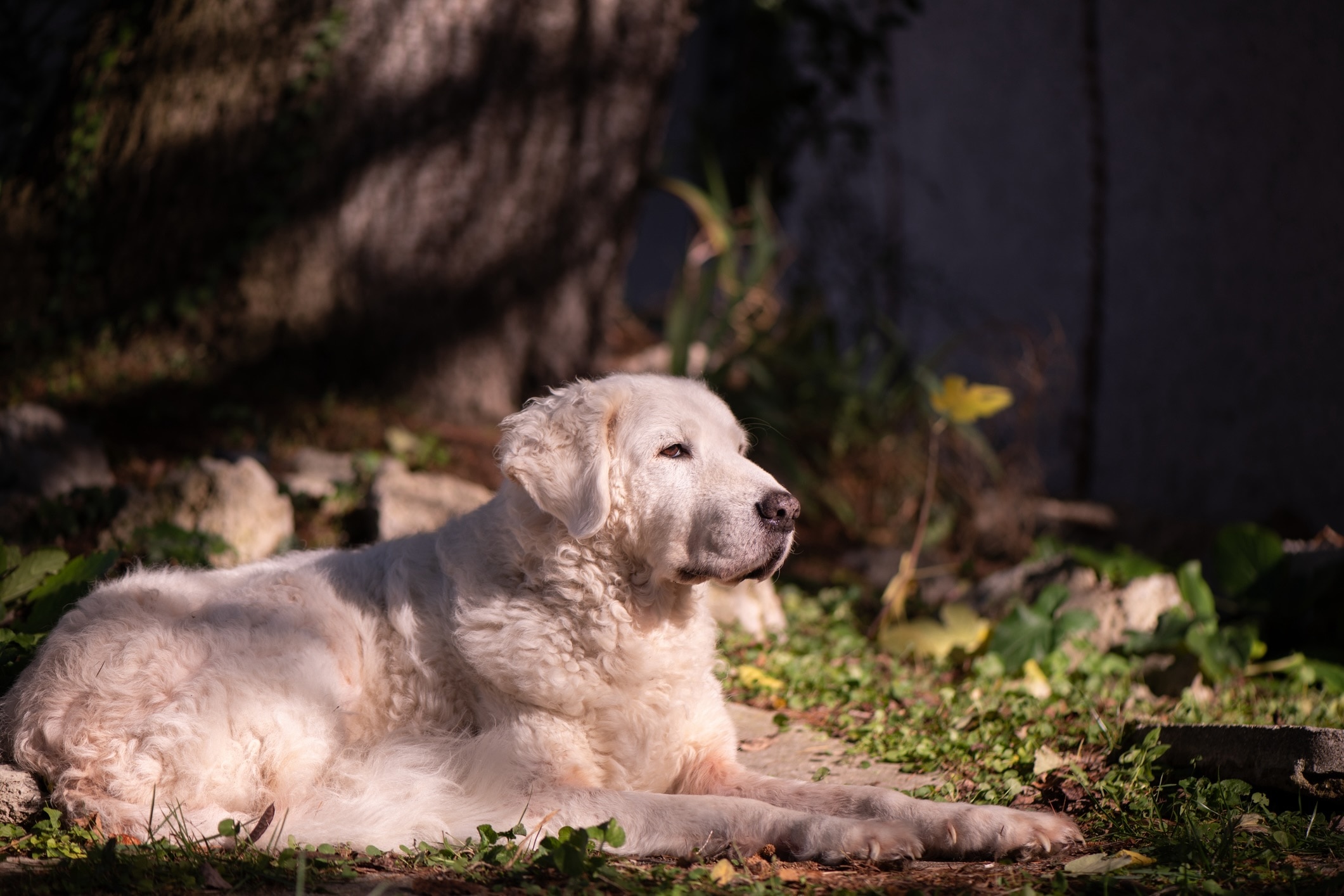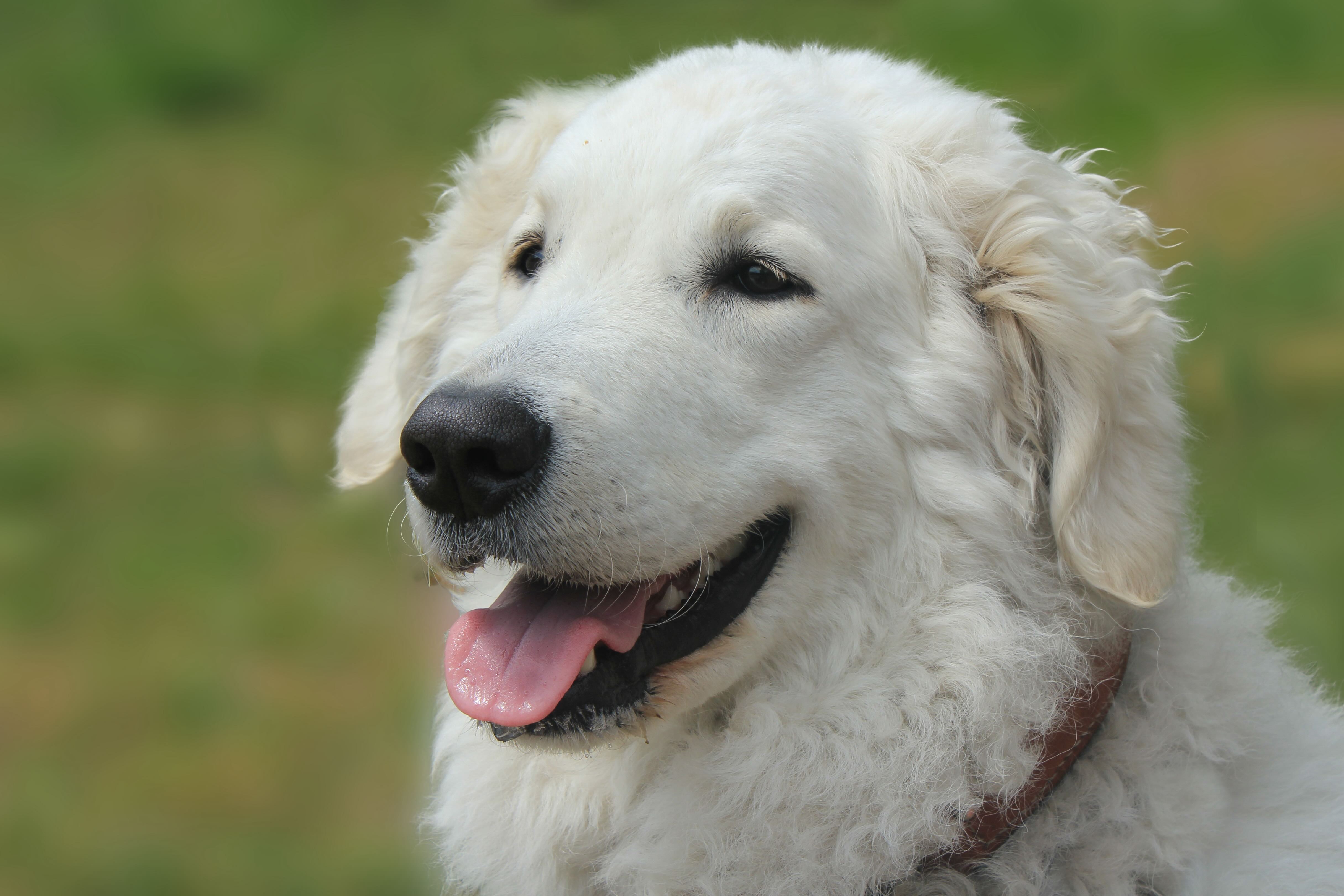Kuvasz
La Su/iStock / Getty Images Plus via Getty Images
The Kuvasz is a Hungarian dog breed believed to have ancient origins, but the breed’s modern history can be traced to the region of the Ural Mountains in Siberia.
Herders relied on these capable, large-boned dogs with thick white coats to serve as livestock guardians. Later, the Magyar people migrated from Siberia to what would become Hungary. They brought their dogs along, which were invaluable in watching livestock while also serving as hunting partners and personal guardians.
Today, Kuvaszok (the plural of the dog breed Kuvasz) have retained their watchful traits and nurturing personality. This makes them an excellent livestock guardian and a gentle companion, too.
A mature Kuvasz dog measures 26–30 inches tall at the shoulder and weighs 70–115 bounds.
Caring for a Kuvasz
The Kuvasz dog breed balances guarding instincts with an easygoing nature. They’re known to be gentle and tolerant around other animals and children when well-trained and socialized.
But this can be a challenging breed for a first-time pet parent, thanks to their working temperament. These large working dogs need a job to do and consistent physical exertion—either from watching over livestock, or with structured exercise to tire their body and stimulate their mind. They also have a strong drive to escape their fenced-in space and roam.
Kuvasz Health Issues

The Hungarian Kuvasz is known for being a healthy dog with an average lifespan of 10–12 years. But like all dogs, Kuvaszok can develop certain conditions during their life.
Hip and Elbow Dysplasia
Hip dysplasia is a disorder that affects the development of the hip socket, leading to a deformed femur head and shallow hip socket. Similarly, elbow dysplasia leads to a loose elbow joint. Both can cause arthritis and mobility issues, especially as the dog ages.
Surgery, joint supplements, and/or medications can help to remedy these problems, especially if the disease is diagnosed early.
Bloat and Gastric Dilatation-Volvulus (GDV)
Because the Kuvasz is a deep-chested breed, the dogs can suddenly develop a life-threatening condition called gastric dilatation-volvulus. This is a severe form of bloat in dogs in which the stomach fills with food and gas during mealtime and then twists, cutting off blood flow to the stomach and spleen.
The signs of bloat and GDV include:
-
A distended abdomen
-
Retching without producing vomit
-
Excessive drooling
-
Signs of discomfort, such as pacing or an inability to settle
Take your dog to the emergency veterinarian immediately if you notice any signs of GDV in your Kuvasz.
Hypothyroidism
Hypothyroidism is an endocrine disease caused when the thyroid glands don’t produce enough hormones. Symptoms of hypothyroidism include:
-
Weight gain
-
Lethargy
-
Heat-seeking behavior
-
Dry, brittle coat
Hypothyroidism is managed with lifelong medications, and Kuvaszok with the condition can live long, happy lives with proper care.
What To Feed a Kuvasz

Choose a high-quality dog food that meets the guidelines set by the Association of American Feed Control Officials (AAFCO).
For Kuvasz puppies, choose a formula specifically targeted to meet the needs of large-breed puppies. This can help minimize the chance of hip dysplasia and other diseases related to the breed’s large size and quick growth.
How To Feed a Kuvasz
A full-grown Kuvasz dog should typically be fed at least two meals a day of a life stage-appropriate dog food (puppy, adult, or senior).
You can use treats for training or to address specific needs, such as dog dental treats. But use treats in moderation and don’t overlook their contribution to your dog’s total calorie intake. In general, treats should make up no more than 10% of a dog’s daily calories.
To reduce the risk of GDV in your Kuvasz:
-
Use a slow feeder bowl to reduce your dog’s rate of eating.
-
Avoid using elevated food bowls.
-
Restrict exercise directly before or after feeding your dog.
-
Feed your Kuvasz multiple meals per day instead of one large meal.
How Much Should You Feed a Kuvasz?
A working dog of the Kuvasz size will need more calories than small breed companion dogs, but you should still measure your dog’s food rather than rely on guesswork for portion sizes.
Use the feeding guidelines on your dog food packaging or ask your vet for recommendations based on your dog’s age, weight, and activity level.
Nutritional Tips for Kuvaszok
Since large-breed dogs like the Kuvasz are somewhat prone to joint problems, your vet might recommend a joint supplement or a joint-health diet. If you have specific concerns, discuss them with your veterinarian.
In general, most dogs fed an AAFCO-approved diet don’t require routine supplementation unless other problems present themselves. Never give your dog a supplement without your vet’s guidance.
Behavior and Training Tips for Kuvaszok
Kuvasz Personality and Temperament

Kuvasz dogs are best described as confident and intelligent. The breed isn’t known for being overly energetic or strong-willed, but they have the capacity for independent thinking. This is a trait that serves them well as livestock guardians but can work against an inexperienced dog parent.
Because the Hungarian Kuvasz was bred to do a job, don’t expect these dogs to be couch potatoes. They need an outlet for their energy and thrive when given a purpose in life and regular exercise.
While the dogs are known for their gentle nature, you should diligently socialize Kuvasz puppies with children and other animals to ensure safe, diplomatic interactions.
Kuvasz Behavior
Kuvasz dogs are noted for their calm demeanor and attentiveness to their family and home. The breed has a secure nature that keeps them from becoming overly anxious, but their watchful instinct makes them reserved around strangers. Socialize your Kuvasz puppy from an early age so your dog will feel comfortable around newcomers.
Kuvasz Training
Clear, consistent training that uses positive reinforcement methods is the key to successfully training this breed.
Kuvaszok are known to have a sensitive nature, so harsh training methods can deteriorate the bond between dog and pet parent. At the same time, spotty or nonexistent training regiments can result in undesirable behaviors.
To have a well-balanced, confident family companion, do not neglect training.
Fun Activities for Kuvaszok
-
Nose work
Kuvasz Grooming Guide

The Kuvasz’s white double coat is thick and wavy, giving the dog adequate protection against harsh outdoor elements. It requires minimal grooming upkeep, but you can expect significant shedding—especially as summer approaches.
Skin Care
No special skin care is required for the Kuvasz. The dog’s double coat does an excellent job of repelling dirt and protecting the skin, so bathing is not a routine requirement either. You can occasionally bathe a Kuvasz, especially if he becomes extra dirty, but it’s not necessary to do it on a fixed regimen.
Coat Care
Regular brushing is the key to caring for the coat of a Kuvasz dog.
By brushing your dog’s double coat a few times a week, you can remove loose fur and ensure the coat stays free of tangles and mats. In addition, use an undercoat rake or deshedding tool weekly if you want to reduce shedding.
Eye Care
Kuvasz dogs usually don’t require special eye care. But when brushing your dog, regularly check the eyes for cloudiness, irritation, or discharge.
And while any dog can develop tear stains, it can be more noticeable in dogs with white coats. Although the Kuvasz dog breed isn’t especially prone to tear staining, you may need to take extra steps to cleanse the fur around the eyes if this issue develops.
Ear Care
The Kuvasz’s folded ears mean moisture and debris can easily become trapped. It also means you won’t see what’s happening underneath without lifting the ear up and away from the head, so ear infections can develop easily.
It’s a good idea to regularly check your pet’s ears while petting or brushing your dog. Inspect them for signs of an ear infection, and talk to your vet about how to clean your dog’s ears and which ear cleaning products you should use.
Considerations for Pet Parents

Kuvasz puppies are almost too cute to resist, and adult Kuvasz dogs have a majestic appearance. But don’t pick a pet based on what meets the eye.
It’s important to understand that the Kuvasz is a large-breed dog with the need for exercise, stimulation, and room to roam. These dogs are not good for apartment living and require consistent training and exercise.
Without proper training, they can become headstrong. This means a Kuvasz is usually not the best breed for new or inexperienced dog parents. But if you’re looking for a loyal and intelligent large dog, the Kuvasz is a top option if you’re experienced and dedicated.
Kuvasz FAQs
Is a Kuvasz a good family dog?
Kuvaszok can make excellent family dogs for the right family. They are known to be gentle and affectionate toward those they love, but they need lots of exercise, mental stimulation, and a dedicated trainer who will socialize them to be comfortable around new people.
What is the difference between a Great Pyrenees and a Kuvasz?
It’s easy to see the similarities between the Kuvasz and the Great Pyrenees. Both breeds have an impressive stature with white, fluffy coats. Look closer, though, and you’ll notice the Kuvasz often has a coat with more curl than the straighter coat of the Great Pyrenees.
And while both breeds excel as livestock guardians and are renowned for their patience with children, the Great Pyrenees hail from the Pyrenees Mountains in southeast Europe, while the origins of the Kuvasz track further north into Siberia.
How much does a Kuvasz cost?
The price for a Kuvasz puppy from a reputable breeder is typically $1,500–$2,000.
